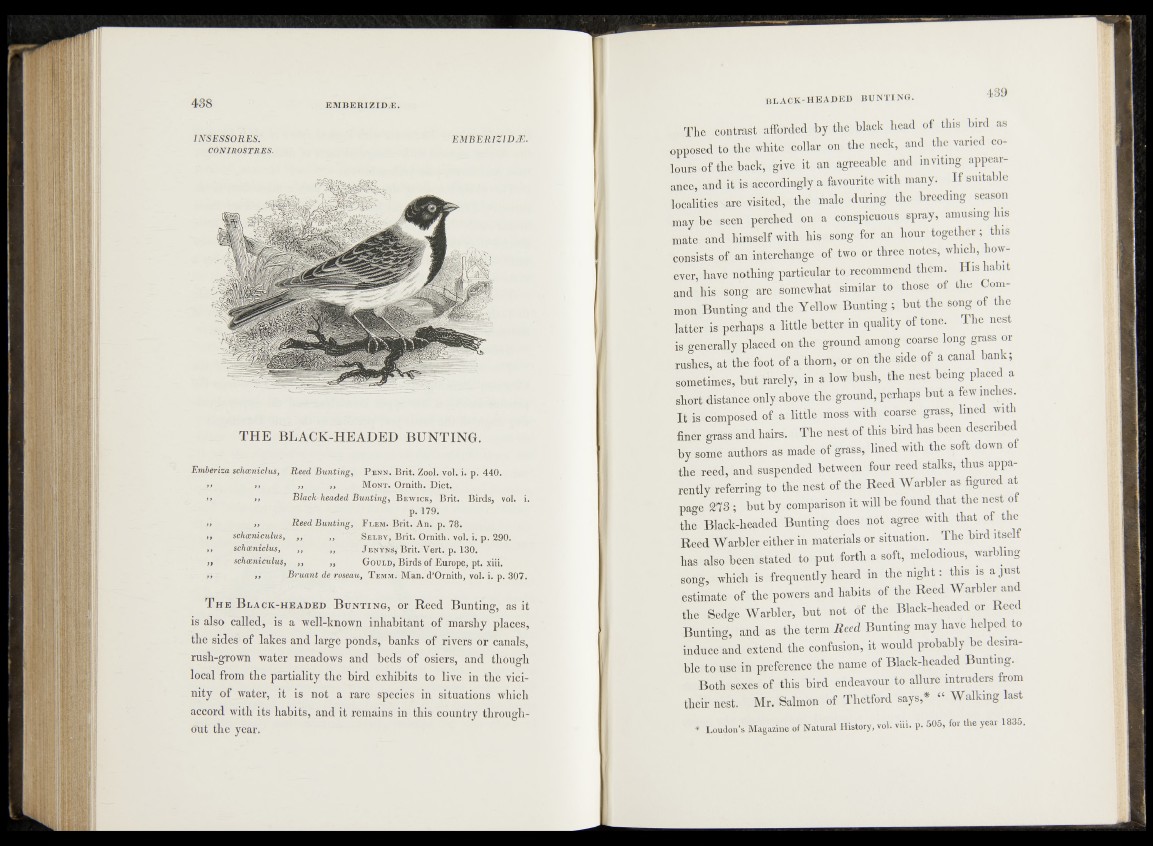
1NSESS0RES. EMBERIZIDÆ.
CONIROSTRES.
TH E BLACK-HEADED BUNTING.
Emberiza schoeniclus, Reed Bunting, P enn. Brit. Zool. vol. i. p. 440.
>> ,, ,, ,, Mont. Ornith. Diet.
>> >i Black-headed Bunting, B ewick, Brit. Birds, vol. i.
p. 179.
» ,, Reed Bunting, F lem. Brit. An. p. 78.
,, schoeniculus, ,, ,, Selby, Brit. Ornith. vol. i. p. 290.
>> schoeniclus, ,, ,, J enyns, Brit. Vert. p. 130.
,, schoeniculus, ,, ,, Gould, Birds of Europe, pt. xiii.
>> n Bruant de roseau, Temm. Man. d’Ornith, vol. i. p. 307.
T he B lack-headed B unting, or Reed Bunting, as it
is also called, is a well-known inhabitant of marshy places,
the sides of lakes and large ponds, banks of rivers or canals,
rush-grown water meadows and beds of osiers, and though
local from the partiality the bird exhibits to live in the vicinity
of water, it is not a rare species in situations which
accord with its habits, and it remains in this country throughout
the year.
The contrast afforded by the black head of this bird as
opposed to the white collar on the neck, and the varied colours
of the back, give it an agreeable and inviting appearance,
and it is accordingly a favourite with many. If suitable
localities are visited, the male during the breeding season
may be seen perched on a conspicuous spray, amusing his
mate and himself with his song for an hour together; this
consists of an interchange of two or three notes, which, however,
have nothing particular to recommend them. His habit
and his song are somewhat similar to those of the Common
Bunting and the Yellow Bunting ; but the song of the
latter is perhaps a little better in quality of tone. The nest
is generally placed on the ground among coarse long grass or
rushes, at the foot of a thorn, or on the side of a canal bank;
sometimes, but rarely, in a low bush, the nest being placed a
short distance only above the ground, perhaps but a few inches.
It is composed of a little moss with coarse grass, lined with
finer grass and hairs. The nest of this bird has been described
by some authors as made of grass, lined with the soft down of
the reed, and suspended between four reed stalks, thus apparently
referring to the nest of the Reed Warbler as figured at
page 273 ; but by comparison it will be found that the nest of
the Black-headed Bunting does not agree with that of the
Reed Warbler either in materials or situation. The bird itse
has also been stated to put forth a soft, melodious, warbling
song, which is frequently heard in the nig h t: this is a just
estimate of the powers and habits of the Reed Warbler and
the Sedge Warbler, but not of the Black-headed or Reed
Bunting, and as the term Reed Bunting may have helped to
induce and extend the confusion, it would probably be desirable
to use in preference the name of Black-headed Bunting.
Both sexes of this bird endeavour to allure intruders from
their nest. Mr. Salmon of Thetford says,* “ Walking last
* Loudon’s Magazine of Natural History, vol. vui. p. 505, for the year 1835.